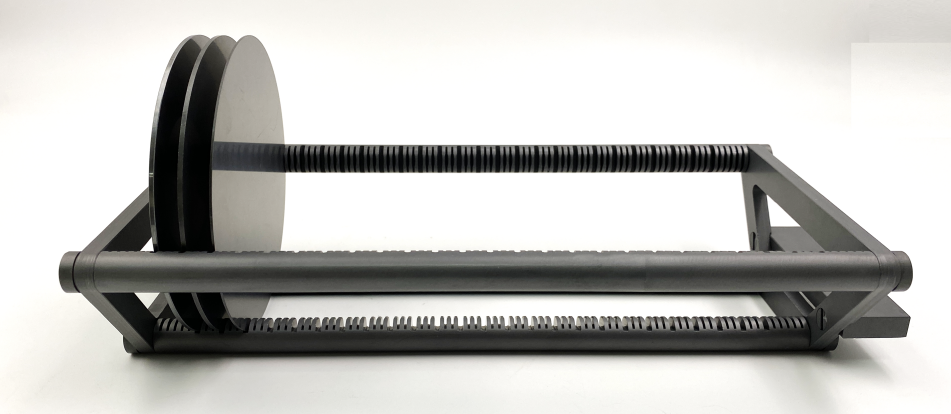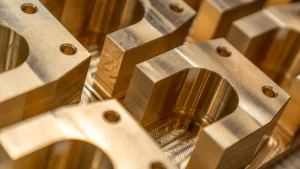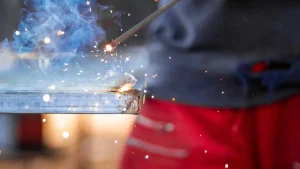Silicon carbide (SiC) wafer holders play a pivotal role in semiconductor manufacturing due to their exceptional material properties. Their high thermal conductivity ensures efficient heat dissipation, critical for maintaining performance in high-temperature environments. Additionally, SiC’s superior mechanical strength and chemical resistance make it ideal for withstanding the rigorous demands of semiconductor processes. These attributes not only enhance durability but also contribute to the precision required in advanced electronic applications. As industries increasingly demand energy-efficient solutions, the SiC wafer holder has become indispensable in enabling reliable and high-performance semiconductor devices.

要点
- SiC wafer holders offer exceptional thermal conductivity, ensuring efficient heat dissipation and preventing overheating in high-temperature semiconductor processes.
- The high mechanical strength and rigidity of SiC provide precise wafer positioning, crucial for maintaining accuracy during critical manufacturing steps.
- SiC’s chemical resistance allows it to withstand harsh environments, making it ideal for applications involving corrosive substances.
- With a low coefficient of thermal expansion, SiC wafer holders maintain stability during temperature fluctuations, reducing the risk of thermal stress and operational errors.
- Despite their high manufacturing costs, ongoing innovations aim to make SiC materials more affordable, enhancing their accessibility for various industries.
- SiC wafer holders are lightweight yet durable, making them suitable for aerospace and defense applications where performance under extreme conditions is essential.
- The adoption of SiC wafer holders in semiconductor manufacturing leads to improved efficiency, reduced energy loss, and enhanced device longevity.
Key Material Properties of SiC Wafer Holders
熱伝導率
High thermal conductivity for efficient heat dissipation.
Silicon carbide (SiC) wafer holders exhibit exceptional thermal conductivity, a property that ensures efficient heat dissipation during semiconductor manufacturing. This characteristic is crucial in processes where high temperatures are involved, as it prevents overheating and maintains the stability of the wafers. The ability of SiC to evenly distribute heat across its surface minimizes thermal gradients, reducing the risk of thermal stress and deformation. This makes SiC wafer holders indispensable in high-power and high-temperature applications, such as epitaxy and ion implantation.
Role in maintaining performance at high temperatures.
SiC materials maintain their thermal properties even at extreme temperatures, often exceeding 1,400°C. This resilience allows SiC wafer holders to perform reliably in demanding environments where traditional materials might fail. By ensuring consistent thermal management, these holders contribute to the precision and efficiency required in advanced semiconductor processes. Their superior heat resistance also enhances the longevity of the equipment, reducing downtime and maintenance costs.
Mechanical Strength and Hardness
High Young’s modulus ensuring structural integrity.
The mechanical strength of SiC wafer holders stems from their high Young’s modulus, which exceeds 400 GPa. This property ensures excellent structural integrity, even under significant mechanical stress. SiC wafer holders can withstand heavy loads and maintain their shape without deformation, making them ideal for applications requiring precise wafer positioning. Their rigidity also supports the secure handling of wafers during critical processes, such as chemical vapor deposition (CVD) and physical vapor deposition (PVD).
Resistance to wear and mechanical stress.
SiC wafer holders demonstrate remarkable hardness and wear resistance, which are essential for enduring the repetitive mechanical stresses of semiconductor manufacturing. These properties protect the holders from surface damage, such as scratches or abrasions, ensuring a longer operational lifespan. The durability of SiC also reduces the risk of contamination, as the material resists particle generation during use. This makes SiC wafer holders a reliable choice for maintaining cleanroom standards in semiconductor facilities.
耐薬品性
Durability in corrosive environments.
SiC wafer holders excel in environments where exposure to corrosive chemicals is common. Their chemical inertness allows them to resist degradation when subjected to acids, alkalis, and other harsh substances used in semiconductor processes. This durability ensures that the holders retain their structural and functional integrity over time, even in aggressive chemical conditions. As a result, they provide a stable platform for wafers during etching, cleaning, and other chemical treatments.
Compatibility with harsh semiconductor processes.
The compatibility of SiC wafer holders with harsh semiconductor processes further enhances their value. They can endure the rigorous demands of high-temperature and high-pressure environments without compromising performance. This adaptability makes them suitable for a wide range of applications, from power electronics to photovoltaic manufacturing. By maintaining their properties under challenging conditions, SiC wafer holders contribute to the production of high-quality semiconductor devices.
Low Thermal Expansion
Stability under extreme temperature fluctuations.
Silicon carbide (SiC) wafer holders demonstrate exceptional stability when exposed to extreme temperature fluctuations. This property arises from the material’s low coefficient of thermal expansion, which minimizes dimensional changes during rapid heating or cooling cycles. In semiconductor manufacturing, where processes often involve abrupt temperature shifts, this stability ensures precise wafer positioning and alignment. The ability of SiC wafer holders to maintain their structural integrity under such conditions reduces the likelihood of operational errors, enhancing the overall efficiency of production systems.
SiC’s low thermal expansion also contributes to its suitability for high-power and high-temperature applications. For instance, in epitaxy and ion implantation processes, the material’s resistance to thermal distortion ensures consistent performance. This reliability makes SiC wafer holders indispensable in environments requiring exacting standards of precision and durability.
Prevention of thermal stress and cracking.
The low thermal expansion of SiC wafer holders plays a critical role in preventing thermal stress and cracking. When materials expand or contract unevenly due to temperature changes, internal stresses can develop, leading to fractures or deformations. SiC’s inherent ability to resist such expansion minimizes these risks, ensuring the longevity and reliability of the wafer holder. This characteristic is particularly valuable in semiconductor processes that involve prolonged exposure to high temperatures, such as chemical vapor deposition (CVD) or physical vapor deposition (PVD).
Moreover, the robust thermal properties of SiC wafer holders reduce maintenance requirements and downtime. By preventing thermal-induced damage, these holders contribute to cost savings and operational efficiency. Their durability under challenging conditions further underscores their importance in advanced semiconductor manufacturing, where precision and reliability are paramount.
Advantages of SiC Wafer Holders in Applications
半導体製造
Precision and reliability in wafer handling.
SiC wafer holders provide unmatched precision in semiconductor manufacturing. Their rigid structure ensures accurate wafer positioning, which is critical for processes like lithography and etching. The high mechanical strength of SiC prevents deformation, maintaining the integrity of wafers during handling. This reliability reduces errors and enhances the overall yield of semiconductor devices. Manufacturers rely on SiC wafer holders to meet the stringent demands of modern semiconductor production.
Compatibility with high-temperature and high-voltage processes.
The exceptional thermal conductivity of SiC enables its use in high-temperature environments. SiC wafer holders efficiently dissipate heat, ensuring stable performance during processes such as epitaxy and ion implantation. Their ability to withstand temperatures exceeding 1,400°C makes them indispensable for high-voltage applications. This compatibility allows manufacturers to produce advanced devices with greater efficiency and reliability. The durability of SiC also minimizes downtime, contributing to cost-effective operations.
High-Performance Electronics
Use in power electronics and high-frequency devices.
SiC wafer holders play a vital role in the development of power electronics. Their material properties support the fabrication of devices that operate at high voltages and frequencies. SiC’s wide bandgap and low intrinsic carrier concentration enhance the performance of these devices, making them suitable for applications like electric vehicles and renewable energy systems. The use of SiC wafer holders ensures the precision required for producing high-quality electronic components.
Enhanced efficiency and reduced energy loss.
The superior thermal conductivity of SiC minimizes energy loss in electronic devices. By efficiently dissipating heat, SiC wafer holders prevent overheating, which can degrade device performance. This efficiency translates to lower energy consumption and improved device longevity. Industries focused on sustainability and energy efficiency benefit significantly from the adoption of SiC wafer holders in their manufacturing processes.
航空宇宙および防衛アプリケーション
Performance in extreme environments.
SiC wafer holders excel in aerospace and defense applications due to their ability to perform under extreme conditions. Their resistance to high temperatures, mechanical stress, and chemical exposure ensures reliability in challenging environments. These properties make SiC wafer holders ideal for advanced systems used in satellites, aircraft, and defense technologies. Their consistent performance enhances the safety and effectiveness of critical operations.
Lightweight and durable for advanced systems.
The lightweight nature of SiC, combined with its exceptional durability, offers significant advantages in aerospace and defense. SiC wafer holders reduce the overall weight of systems without compromising strength or functionality. This characteristic is particularly valuable in applications where weight reduction is crucial, such as space exploration. The durability of SiC ensures long-term performance, reducing maintenance requirements and operational costs.
Challenges and Limitations of SiC Wafer Holders
High Manufacturing Costs
Factors contributing to high costs of SiC materials.
The production of silicon carbide (SiC) materials involves complex and energy-intensive processes. SiC requires high-temperature synthesis, often exceeding 2,000°C, to achieve its crystalline structure. This process demands specialized equipment and significant energy consumption, which increases production costs. Additionally, the raw materials used in SiC manufacturing, such as silicon and carbon, must meet stringent purity standards to ensure optimal performance. These factors collectively contribute to the high cost of SiC wafer holders.
Another challenge lies in the precision required during the fabrication of SiC components. Advanced techniques, such as chemical vapor deposition (CVD), are often employed to create SiC Process Tubes, SiC Wafer Boats, and SiC Focus Rings. These methods, while effective, are expensive and time-consuming. Furthermore, the polishing and finishing of SiC surfaces require meticulous attention to detail, adding to the overall cost. Compared to traditional silicon wafer holders, SiC wafer holders demand a significantly higher investment due to these manufacturing complexities.
Innovations in production to reduce costs.
Despite the high costs, ongoing innovations aim to make SiC materials more affordable. Researchers are exploring alternative synthesis methods, such as microwave-assisted heating, to reduce energy consumption during production. Advances in additive manufacturing, including 3D printing, also show promise in lowering fabrication costs by minimizing material waste and streamlining production processes.
Manufacturers are investing in scaling up production capacities to meet the growing demand for SiC wafer holders in industries like electric vehicles and renewable energy. Economies of scale can help reduce unit costs over time. Additionally, the development of hybrid materials, such as SiC-coated graphite, offers a cost-effective alternative while retaining many of the desirable properties of pure SiC. These innovations aim to balance performance with affordability, making SiC wafer holders more accessible for various applications.
Brittle Nature of SiC
Risks of cracking under mechanical stress.
Silicon carbide, while exceptionally strong, exhibits a brittle nature that poses challenges in certain applications. Its high hardness, which contributes to wear resistance, also makes it prone to cracking under mechanical stress. During semiconductor manufacturing, where precise handling of wafers is critical, even minor impacts or uneven pressure can lead to fractures in SiC wafer holders. This brittleness limits their ability to withstand sudden shocks or heavy loads, increasing the risk of damage during operation.
The brittleness of SiC also complicates its machining and shaping. Traditional silicon wafer holders, being more ductile, are easier to process and less likely to chip or crack during fabrication. In contrast, SiC wafer holders require advanced machining techniques, which not only increase production costs but also heighten the risk of defects. This characteristic necessitates careful design and handling to prevent failures in demanding environments.
Design improvements to mitigate brittleness.
To address the brittleness of SiC, manufacturers are implementing innovative design strategies. Reinforced structures, such as honeycomb patterns, distribute mechanical stress more evenly, reducing the likelihood of cracking. The integration of composite materials, like SiC-coated graphite, enhances durability while maintaining the thermal and chemical resistance of pure SiC. These designs optimize the performance of SiC wafer holders in applications requiring high precision and reliability.
Surface treatments and coatings also play a crucial role in mitigating brittleness. Techniques like ion implantation and laser annealing improve the toughness of SiC surfaces, making them less susceptible to cracking. Additionally, advancements in material science have led to the development of doped SiC variants, which exhibit enhanced mechanical properties. By tailoring the composition and structure of SiC materials, manufacturers can overcome the limitations of brittleness and expand their usability in high-stress environments.
Silicon carbide (SiC) wafer holders stand out due to their exceptional material properties, including high thermal conductivity, mechanical strength, chemical resistance, and low thermal expansion. These attributes ensure durability and precision, making them indispensable in semiconductor manufacturing and other advanced applications. Their ability to perform under extreme conditions highlights their versatility across industries like aerospace, defense, and high-performance electronics. Understanding these properties is crucial for selecting the right wafer holder, as it directly impacts efficiency, reliability, and long-term performance in demanding environments.
よくあるご質問
What makes SiC wafer holders superior to traditional silicon wafer holders?
Silicon carbide (SiC) wafer holders outperform traditional silicon holders due to their exceptional material properties. SiC offers higher thermal conductivity, enabling efficient heat dissipation during high-temperature processes. Its superior mechanical strength and hardness ensure durability under mechanical stress, while its chemical resistance allows it to withstand corrosive environments. These attributes make SiC wafer holders indispensable for advanced semiconductor manufacturing.
Why is thermal conductivity important in SiC wafer holders?
Thermal conductivity plays a critical role in maintaining the performance and reliability of SiC wafer holders. High thermal conductivity ensures efficient heat dissipation, preventing overheating during semiconductor processes. This property reduces thermal stress and deformation, which are essential for precision in applications like epitaxy and ion implantation. SiC’s ability to handle extreme temperatures enhances its suitability for high-power and high-temperature environments.
How does the brittleness of SiC impact its usability?
The brittleness of SiC presents challenges in handling and machining. Its high hardness makes it prone to cracking under mechanical stress or sudden impacts. However, manufacturers address this limitation through innovative designs, such as reinforced structures and composite materials like SiC-coated graphite. These advancements enhance the durability of SiC wafer holders while retaining their thermal and chemical resistance.
Are SiC wafer holders suitable for high-power applications?
Yes, SiC wafer holders are ideal for high-power applications. Their wide bandgap and stable electrical properties support devices operating at high voltages and frequencies. SiC’s superior thermal conductivity and temperature stability make it suitable for power electronics, electric vehicles, and industrial systems. These properties ensure consistent performance and reliability in demanding environments.
What industries benefit most from SiC wafer holders?
SiC wafer holders find applications across various industries, including semiconductor manufacturing, aerospace, defense, and high-performance electronics. In semiconductor manufacturing, they provide precision and reliability in wafer handling. Aerospace and defense industries value their lightweight and durable nature, while high-performance electronics benefit from their ability to enhance efficiency and reduce energy loss.
How do SiC wafer holders contribute to cleanroom standards?
SiC wafer holders maintain cleanroom standards by resisting wear and particle generation. Their hardness and wear resistance prevent surface damage, such as scratches or abrasions, ensuring a longer operational lifespan. This durability minimizes contamination risks, making them a reliable choice for maintaining the stringent cleanliness required in semiconductor facilities.
What are the cost challenges associated with SiC wafer holders?
The production of SiC wafer holders involves complex and energy-intensive processes, contributing to high manufacturing costs. High-temperature synthesis, advanced machining techniques, and stringent purity standards increase expenses. However, innovations like additive manufacturing and alternative synthesis methods aim to reduce costs while maintaining performance.
Can SiC wafer holders be used in harsh environments?
SiC wafer holders excel in harsh environments due to their chemical resistance, thermal stability, and mechanical strength. They endure exposure to corrosive chemicals, extreme temperatures, and mechanical stress without compromising performance. These properties make them suitable for applications in power electronics, high-temperature sensors, and high-strength ceramics.
What role do SiC wafer holders play in advanced semiconductor processes?
SiC wafer holders provide a stable platform for semiconductor layering and processing. Their low thermal expansion ensures dimensional stability during rapid temperature changes, reducing the risk of thermal stress and cracking. This precision is crucial for processes like chemical vapor deposition (CVD) and physical vapor deposition (PVD), where exacting standards are required.
How do SiC-coated graphite wafer holders enhance performance?
SiC-coated graphite wafer holders combine the benefits of SiC’s thermal and chemical resistance with graphite’s lightweight properties. This combination enhances wear resistance and maintains precise dimensions for optimal wafer handling. These holders improve reliability and consistency in processes like epitaxy, making them valuable for advanced semiconductor manufacturing.
製品の詳細については、下記までお問い合わせください。 steven@china-vet.com またはウェブサイト: www.vet-china.com.






